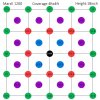So I see a lot of questions regarding LEDs, and most answers are somewhere, scattered around the web. I took an interest to LEDs recently, trying to answer all the questions I had. How they work, what makes one light better than another, what spectrum is best; a lot to try and research.
I'm gonna try to get down everything necessary for understanding leds on the market today. And understanding how much light they actually produce. If anyone thinks something should be added, or if anything is incorrect, let me know. This is to the best of my understanding of the terms and math.
Common LED terms
LED - light emitting diode. Works on electroluminescence, a material that emits light from electricity.
COB - chip on board. Multiple diodes in a single chip.
Mono - Single color leds, used usually to refer to single diode chips.
Spectrum - the distribution of light at different wavelengths.
Watts - a measurement of energy usage. 1 watt = 1joule/second. Kilowatt hours or kWh is how you're usually charged on your electric bill, or 1000 watts used for 1 hour.
Nanometer - unit of measurement for light wavelengths.
Color - used to describe the appearance of white light in kelvins. Usually ranges from 2700k, a warm yellow glow, to 6500k, a light blue color.
CRI - how closely a light matches the spectral distribution of the sun.
Lux - a measurement of light, adjusted to how the human eye sees it.
Lumens - the average lux a light source will emit over a square meter.
PAR - photosynthetic active radiation, light in the 400-700 nanometer range. Often measured in ppfd
PPFD - photosynthetic photon flux density, a measurement of the photon density of a specific area. A measure of photon count.
PPF - the average ppfd a light source will emit over 1 square meter. Plant equivalent of lumens.
Photon - A quantum measurement of light (as both a particle and a wave)
Micromole - how we measure photons. Seen as µmols or often "umols" improperly.
Driver - or power supply. The AC/DC converter for Led strings.
Beam angle - to describe the spread of a light source or optic. References the point where 1/2 the light level of the center would fall.
Optics - used to direct light or adjust the spread pattern.
Lens - cover the diode, type of optic. May adjust all light emitted from the led.
Reflector - outside the diode, adjusts the outer area of the leds beam angle.
Diffuser - over the diode, usually to increase spread and limit hot spots.
Lumen maintenance - rated hours for lumen depreciation, typically LM70, or the hours where light output wound be 70% original intensity.
LER - luminous efficacy of radiation. The amount of lumens produced from 1 watt of radiation for a given spectrum.
QER - quantum efficacy of radiation. Same as LER, but with photon measurement in the 400-700nm range.
I'm gonna try to get down everything necessary for understanding leds on the market today. And understanding how much light they actually produce. If anyone thinks something should be added, or if anything is incorrect, let me know. This is to the best of my understanding of the terms and math.
Common LED terms
LED - light emitting diode. Works on electroluminescence, a material that emits light from electricity.
COB - chip on board. Multiple diodes in a single chip.
Mono - Single color leds, used usually to refer to single diode chips.
Spectrum - the distribution of light at different wavelengths.
Watts - a measurement of energy usage. 1 watt = 1joule/second. Kilowatt hours or kWh is how you're usually charged on your electric bill, or 1000 watts used for 1 hour.
Nanometer - unit of measurement for light wavelengths.
Color - used to describe the appearance of white light in kelvins. Usually ranges from 2700k, a warm yellow glow, to 6500k, a light blue color.
CRI - how closely a light matches the spectral distribution of the sun.
Lux - a measurement of light, adjusted to how the human eye sees it.
Lumens - the average lux a light source will emit over a square meter.
PAR - photosynthetic active radiation, light in the 400-700 nanometer range. Often measured in ppfd
PPFD - photosynthetic photon flux density, a measurement of the photon density of a specific area. A measure of photon count.
PPF - the average ppfd a light source will emit over 1 square meter. Plant equivalent of lumens.
Photon - A quantum measurement of light (as both a particle and a wave)
Micromole - how we measure photons. Seen as µmols or often "umols" improperly.
Driver - or power supply. The AC/DC converter for Led strings.
Beam angle - to describe the spread of a light source or optic. References the point where 1/2 the light level of the center would fall.
Optics - used to direct light or adjust the spread pattern.
Lens - cover the diode, type of optic. May adjust all light emitted from the led.
Reflector - outside the diode, adjusts the outer area of the leds beam angle.
Diffuser - over the diode, usually to increase spread and limit hot spots.
Lumen maintenance - rated hours for lumen depreciation, typically LM70, or the hours where light output wound be 70% original intensity.
LER - luminous efficacy of radiation. The amount of lumens produced from 1 watt of radiation for a given spectrum.
QER - quantum efficacy of radiation. Same as LER, but with photon measurement in the 400-700nm range.
Attachments
Last edited:








